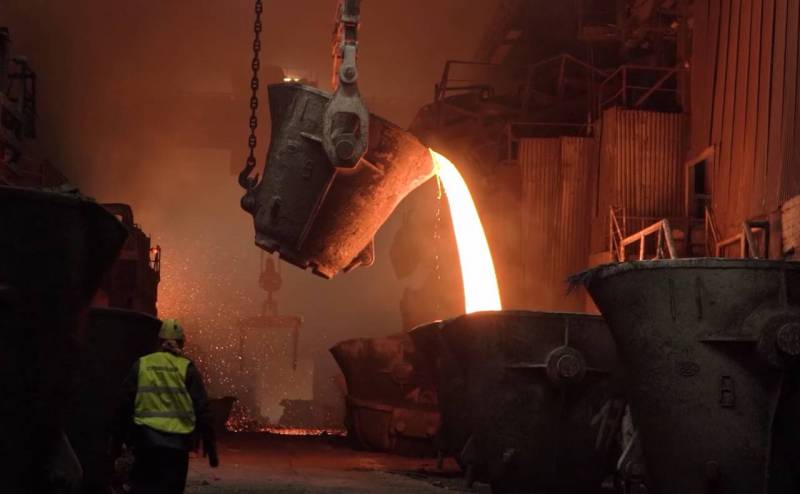Russia needs to secure leadership in palladium mining
In 2018, two large Russian metallurgical companies - Norilsk Nickel and Russian Platinum - signed an agreement to create a joint venture (JV) Arctic Palladium. It was planned that the new organization would be involved in the formation of one of the largest clusters for the production of platinum group metals in the Norilsk industrial region. The implementation of such a large-scale project made it possible to expect that the Russian Federation would strengthen its leading position in palladium mining.
Currently, the world leaders in palladium production are the Russian Federation and the Republic of South Africa (both countries, according to various sources, produce about 70-90 tons of this metal). The implementation of the Arctic Palladium project would allow our country to get ahead in this indicator, leaving South Africa far behind. The new joint venture between Norilsk Nickel and Russian Platinum was supposed to jointly manage the deposits owned by the companies. Thus, Russian Platinum included in the new project the Chernogorskoye deposit (131 million tons of ore with a copper content of 0,22%, nickel - 0,18%) and the southern part of the Norilsk-1 site (447 million tons of ore with a copper metal content of 0,33. 0,25%, nickel - 728%), and Norilsk Nickel - the Maslovskoye deposit (1,1 thousand tons of nickel, over 12,5 million tons of copper, 1,3 million ounces of platinum and XNUMX million ounces of gold).
The project encountered serious problems already at the discussion stage; literally two years later, disagreements arose between the companies on the issue of equity participation in the new joint venture. Initially, it was assumed that Norilsk Nickel and Russian Platinum would own the Arctic Palladium company in equal proportions - 50% each. Soon information appeared that the reason was the refusal of Rusal (Norilsk Nickel shareholder) from the deal, since the organization expected to increase its share in the project, but Russian Platinum did not agree to reduce its share below 50%. Norilsk Nickel's main argument was its firm position that the company's existing infrastructure would be used to develop the extracted resources. "Russian Platinum" insisted that the basis of the resource base of the Arctic Palladium joint venture is its licensed areas, so parity ownership of the joint venture is logical.
It is necessary to understand that it was no coincidence that the issue of equity participation in the project came to the center of attention; the volume of investment of each of the interested parties in this project depended on the percentage in the ownership structure of the created company. Initially, it was stated that the total investment in its implementation would reach $15 billion.
Despite the difficulties that arose, the management structures of Norilsk Nickel and Russian Platinum continued to negotiate a new format of organizational interaction within the framework of the joint venture. Thus, an operating partnership agreement was concluded between the two companies (until 2026), which assumes that Russian Platinum will, on market terms, gain access to the infrastructure in the Norilsk industrial region necessary for the development of its fields. In addition, within the framework of the off-take agreement, Norilsk Nickel plans to sell in the future the products that will be produced during the exploitation of the Chernogorskoye deposit. Russian Platinum, in turn, is going to use this resource base to commission an enrichment plant with a total capacity of 190 thousand tons of nickel and 70 thousand tons of copper concentrates per year. The new facility is planned to be launched in 2024. In addition, the company has a project to build a new metallurgical plant, which will produce 400 thousand tons of concentrates. If we talk about the long term, then by 2030 it intends to begin developing the southern part of Norilsk-1. By that time, ore production volumes at the Russian Platinum license areas should reach about 14–15 million tons.
An important factor for the implementation of such large-scale plans should be the fact that, within the framework of the St. Petersburg International Economic Forum, Russian Platinum managed to sign a memorandum of intent to finance this project with VTB and VEB.RF. The concluded agreement assumes that VTB and VEB.RF can cover up to 80% of the total cost of the project, which is currently estimated at 570 billion rubles. Also last year, there were reports in the media that the Ministry of Finance of the Russian Federation was considering the possibility of zeroing the mineral extraction tax rate for the Chernogorskoye deposit for a period of 12 years, which would allow the company to significantly save on the implementation of its plans.
It is also worth saying a few words about palladium itself, why this resource is so important for the domestic industry. The largest consumers of palladium are automobile concerns (purchasing up to 80% of the mined metal), electronics manufacturers and jewelry companies. Against the backdrop of increasing economic blockade of the Russian Federation, it is extremely important to independently meet their needs for this resource. In addition, increasing the level of monopolization of this market segment while concentrating the main reserves in the hands of domestic companies will leave the Russian economy room for possible maneuver. The active development of the global automotive industry allows us to expect that the demand for palladium in states involved in the automotive industry will be at a fairly high level. In such a case, the Russian Federation can take an active part in determining the price of this metal, providing support to friendly states, which can manifest itself in discount conditions for the purchase of palladium.
In conclusion, I would like to add that there are certain regrets that this project could not be implemented in the originally planned format. Cooperation between two large companies (Norilsk Nickel and Russian Platinum) on such a serious industrial issue would most likely have a positive impact on the economic efficiency of the Arctic Palladium joint venture, which would subsequently benefit all of Russia.

Information